マニュアル
- Unity ユーザーマニュアル 2020.3 (LTS)
- Unity 2020 LTS の新機能
- パッケージ
- 検証済みパッケージ
- 2D Animation
- 2D Pixel Perfect
- 2D PSD Importer
- 2D SpriteShape
- Adaptive Performance
- Adaptive Performance Samsung Android
- Addressables
- Advertisement
- Alembic
- Analytics Library
- Android Logcat
- Animation Rigging
- AR Foundation
- ARCore XR Plugin
- ARKit Face Tracking
- ARKit XR Plugin
- Burst
- Cinemachine
- Code Coverage
- Core RP Library
- Editor Coroutines
- FBX Exporter
- High Definition RP
- In App Purchasing
- Input System
- iOS 14 Advertising Support
- JetBrains Rider Editor
- Magic Leap XR Plugin
- ML Agents
- Mobile Notifications
- Multiplayer HLAPI
- Oculus XR Plugin
- OpenXR Plugin
- Polybrush
- Post Processing
- ProBuilder
- Profile Analyzer
- Quick Search
- Recorder
- Remote Config
- Scriptable Build Pipeline
- Shader Graph
- Test Framework
- TextMeshPro
- Timeline
- Unity Distribution Portal (UDP)
- Universal RP
- Version Control
- Visual Effect Graph
- Visual Studio Code Editor
- Visual Studio Editor
- WebGL Publisher
- Windows XR Plugin
- Xiaomi SDK
- XR Plugin Management
- プレビューパッケージ
- コアパッケージ
- ビルトインパッケージ
- AI
- Android JNI
- Animation
- Asset Bundle
- Audio
- Cloth
- Director
- Image Conversion
- IMGUI
- JSONSerialize
- Particle System
- Physics
- Physics 2D
- Screen Capture
- Terrain
- Terrain Physics
- Tilemap
- UI
- UIElements
- Umbra
- Unity Analytics
- Unity Web Request
- Unity Web Request Asset Bundle
- Unity Web Request Audio
- Unity Web Request Texture
- Unity Web Request WWW
- Vehicles
- Video
- VR
- Wind
- XR
- パッケージをキーワードで探す
- パッケージをキーワードで探す
- Unity の Package Manager
- カスタムパッケージの作成
- 検証済みパッケージ
- Unity を使用する
- Unity のインストール
- Unity のアップグレード
- API アップデーターの使用
- Unity 2020 LTS へのアップグレード
- Unity 2019 LTS へのアップグレード
- Unity 2018 LTS へのアップグレード
- Legacy Upgrade Guides
- Unity のインターフェース
- ゲームの作成
- エディター機能
- 分析
- アセットワークフロー
- 入力
- 2D
- 2D ゲーム
- 2D ソート
- スプライト
- Tilemap
- 2D 物理演算リファレンス
- グラフィックス
- レンダーパイプライン
- カメラ
- ポストプロセス
- ライティング
- モデル
- メッシュ
- テクスチャ
- シェーダー
- シェーダーの基礎概念
- ビルトインシェーダー
- Shader Graph の使用
- シェーダーの作成
- シェーダー作成の概要
- ShaderLab
- ShaderLab: シェーダーオブジェクトの定義
- ShaderLab: SubShader の定義
- ShaderLab: パスの定義
- ShaderLab: シェーダープログラムの追加
- ShaderLab: コマンド
- ShaderLab: Category ブロックによるコマンドのグループ化
- ShaderLab コマンド: AlphaToMask
- ShaderLab コマンド: Blend
- ShaderLab コマンド: BlendOp
- ShaderLab コマンド: ColorMask
- ShaderLab コマンド: Conservative
- ShaderLab コマンド: Cull
- ShaderLab コマンド: Offset
- ShaderLab コマンド: Stencil
- ShaderLab コマンド: UsePass
- ShaderLab コマンド: GrabPass
- ShaderLab コマンド: ZClip
- ShaderLab コマンド: ZTest
- ShaderLabコマンド: ZWrite
- ShaderLab の古い機能
- Unity での HLSL
- Unity での GLSL
- シェーダーの例
- サーフェスシェーダーの記述
- 様々なグラフィックス API のシェーダーの作成
- シェーダーのパフォーマンスとプロファイリング
- マテリアル
- パーティクルシステム
- パーティクルシステムソリューションの選択
- ビルトインのパーティクルシステム
- ビルトインパーティクルシステムの使用
- パーティクルシステム - 頂点ストリームとスタンダードシェーダーサポート
- パーティクルシステム GPU インスタンス
- パーティクルシステム C# Job System インテグレーション
- コンポーネントとモジュール
- パーティクルシステム
- パーティクルシステムモジュール
- Particle System メインモジュール
- Emission モジュール
- Shape モジュール
- Velocity Over Lifetime モジュール
- Noise モジュール
- Limit Velocity Over Lifetime モジュール
- Inherit Velocity モジュール
- Lifetime by Emitter Speed
- Force Over Lifetime モジュール
- Color Over Lifetime モジュール
- Color By Speed モジュール
- Size Over Lifetime モジュール
- Size by Speed モジュール
- Rotation Over Lifetime モジュール
- Rotation By Speed モジュール
- External Forces モジュール
- Collision モジュール
- Triggers モジュール
- Sub Emitters モジュール
- Texture Sheet Animation モジュール
- Lights モジュール
- Trails モジュール
- Custom Data モジュール
- Renderer モジュール
- Particle System Force Field
- ビルトインのパーティクルシステムの例
- Visual Effect Graph
- 環境の作成
- 空
- ビジュアルエフェクトのコンポーネント
- 色
- グラフィックス API サポート
- グラフィックスパフォーマンスの最適化
- 物理演算
- スクリプト
- マルチプレイヤーとネットワーク
- マルチプレイヤーゲーム作成の概要
- マルチプレイヤープロジェクトの設定
- NetworkManager の使用
- Network Manager HUD の使用
- Network Manager HUD の LAN モード
- マッチメーカーモードの Network Manager HUD
- シングルプレイヤーゲームを Unity Multiplayer に変換
- デバッグ情報
- マルチプレイヤー高レベル API
- Multiplayer コンポーネントリファレンス
- Multiplayer クラスリファレンス
- Multiplayer 暗号化プラグイン
- UnityWebRequest
- オーディオ
- オーディオの概要
- オーディオファイル
- トラッカーモジュール
- Audio Mixer
- ネイティブオーディオプラグイン SDK
- Audio プロファイラー
- アンビソニックオーディオ
- オーディオリファレンス
- オーディオクリップ
- Audio Listener
- オーディオソース
- Audio Mixer
- Audio Filter
- Audio Effect
- Audio Low Pass Effect
- Audio High Pass Effect
- Audio Echo Effect
- Audio Flange Effect
- Audio Distortion Effect
- Audio Normalize Effect
- Audio Parametric Equalizer Effect
- Audio Pitch Shifter Effect
- Audio Chorus Effect
- Audio Compressor Effect
- Audio SFX Reverb Effect
- Audio Low Pass Simple Effect
- Audio High Pass Simple Effect
- Reverb Zones
- Microphone(マイク)
- Audio Settings
- ビデオの概要
- アニメーション
- ユーザーインターフェース (UI) の作成
- Unity の UI システムの比較
- UI Toolkit
- Unity UI
- IMGUI (即時モードの GUI)
- ナビゲーションと経路探索
- Unity サービス
- Unity Services のためのプロジェクトの設定
- Unity Organizations
- Unity Ads
- Unity Analytics
- Unity Cloud Build
- Unity Cloud Content Delivery
- Unity IAP
- Unity IAP の設定
- クロスプラットフォームガイド
- ストア ガイド
- ストアの実装
- Unity Collaborate
- Unity Collaborate の設定
- Unity プロジェクトにチームメンバーを加える
- Unity Collaborate の履歴
- Collaborate で Cloud Build を有効にする
- Unity エディターのバージョンの管理
- ファイルを元に戻す
- ファイル競合の解決
- Collaborate への公開時に特定のアセットを除外する
- Collaborate に個別にファイルを公開する
- プロジェクトを以前のバージョンに復元する
- 「編集中」の表示
- クラウドストレージの管理
- プロジェクトを別のバージョン管理システムに移行する
- Unity Accelerator
- Collaborate のトラブルシューティングのヒント
- Unity Cloud Diagnostics
- Unity Integration
- Multiplayer
- Unity Distribution Portal (UDP)
- XR
- オープンソースリポジトリ
- Unity の Asset Store
- プラットフォーム特有の情報
- Unity as a Library を他のアプリケーションで使用
- ディープリンクを有効にする
- スタンドアロン
- macOS
- Linux
- tvOS
- WebGL
- iOS
- Android
- Windows
- Unity を Windows と UWP アプリケーションへ統合
- Windows 全般
- ユニバーサル Windows プラットフォーム
- Getting Started
- Universal Windows Platform: Deployment
- Universal Windows Platform (UWP) build settings
- Windows Device Portal Deployment
- Universal Windows Platform: Profiler
- Universal Windows Platform: Command line arguments
- Universal Windows Platform: Association launching
- AppCallbacks class
- Universal Windows Platform: WinRT API in C# scripts
- ユニバーサル Windows プラットフォームの Player 設定
- Universal Windows Platform: IL2CPP scripting back end
- FAQ
- Universal Windows Platform: Examples
- Universal Windows Platform: Code snippets
- Known issues
- 古いトピック
- 用語集
コントロール
IMGUI コントロールのタイプ
様々な種類の IMGUI コントロール を作成することができます。ここでは、すべての表示と相互作用に関するコントロールを紹介します。その他にもレイアウトのコントロールに影響する IMGUI 機能があり、詳細はドキュメントの IMGUI レイアウトモード で説明しています。
Label
Label は非インタラクティブです。表示専用です。クリックや移動することはできません。情報の表示のみに使用すると良いでしょう。
/* GUI.Label の例 */
using UnityEngine;
using System.Collections;
public class GUITest : MonoBehaviour
{
void OnGUI ()
{
GUI.Label (new Rect (25, 25, 100, 30), "Label");
}
}
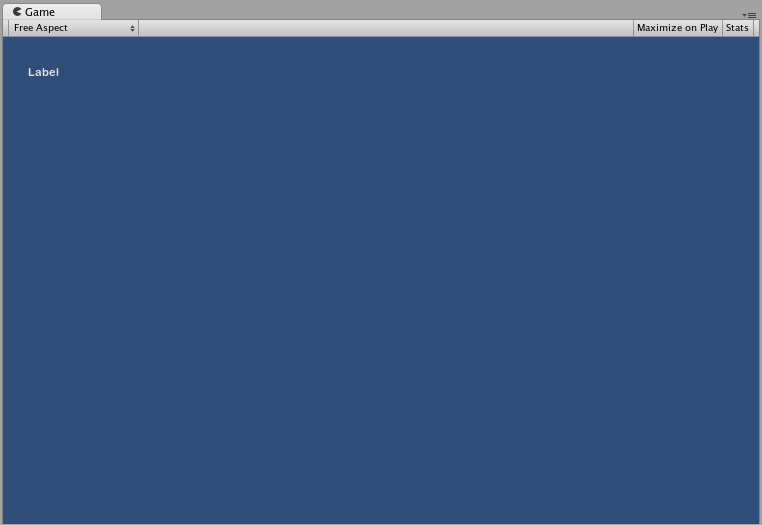
Button
Button は相互作用の目的でよく使用されます。マウスを押し続ける時間に関係なく、クリックすると 1 回だけ反応します。この反応は (押した) ボタンを離した途端に発生します。
基本的な使用例
UnityGUI でボタンをクリックすると、true を返します。ボタンをクリックした際にコードを実行するには、if 構文で GUI.Button 関数をラップします。if 構文内には、ボタンをクリックした際に実行するコードを置きます。
/*GUI.Button の例*/
using UnityEngine;
using System.Collections;
public class GUITest : MonoBehaviour
{
void OnGUI ()
{
if (GUI.Button (new Rect (25, 25, 100, 30), "Button"))
{
// このコードは Button がクリックされたときに実行されます
}
}
}
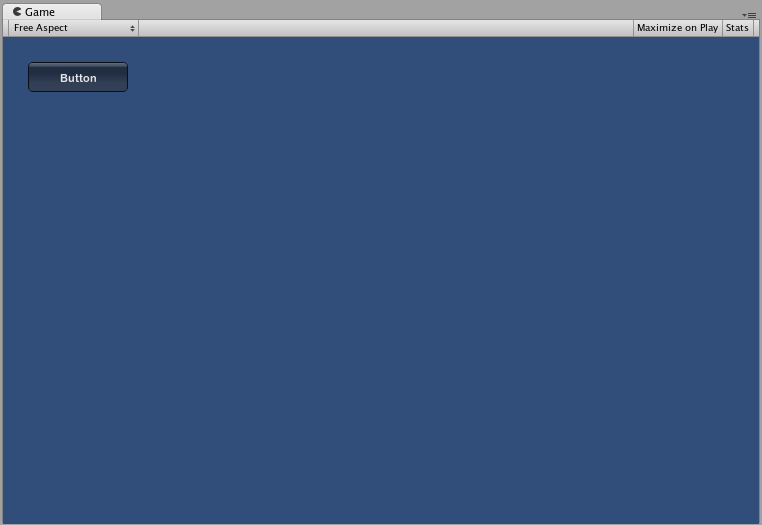
RepeatButton
RepeatButton は、通常の Button の一種です。違いは、RepeatButton の場合は、マウスボタンが押され続けている間のすべてのフレームで反応するということです。これにより、クリックアンドホールド機能を作成できます。
基本的な使用例
UnityGUI で、RepeatButton をクリックすると、毎フレームごとに true を返します。ボタンをクリックした際にコードを実行するには、if 構文で GUI.RepeatButton 関数をラップします。if 構文内には、RepeatButton が押され続けている間に実行されるコードが置かれています。
/*GUI.RepeatButton の例*/
using UnityEngine;
using System.Collections;
public class GUITest : MonoBehaviour
{
void OnGUI ()
{
if (GUI.RepeatButton (new Rect (25, 25, 100, 30), "RepeatButton"))
{
// このコードは RepeatButton が押され続けている間に実行されるすべてのフレームで実行されます
}
}
}
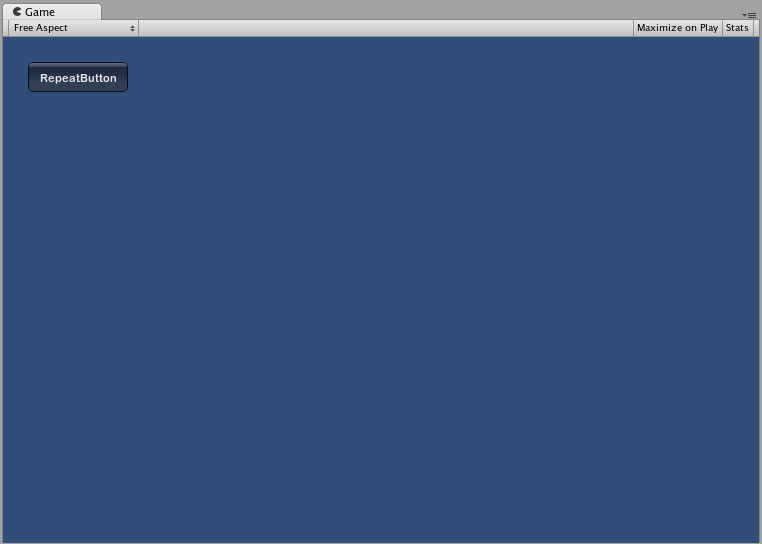
TextField
TextField コントロールは、テキスト文字列を含む、インタラクティブで、編集可能な 1 行のフィールドです。
基本的な使用例
TextField は、常に文字列を表示します。TextField に表示する文字列を用意する必要があります。文字列を編集すると、TextField 関数は編集した文字列を返します。
/* GUI.TextField の例 */
using UnityEngine;
using System.Collections;
public class GUITest : MonoBehaviour
{
private string textFieldString = "text field";
void OnGUI ()
{
textFieldString = GUI.TextField (new Rect (25, 25, 100, 30), textFieldString);
}
}
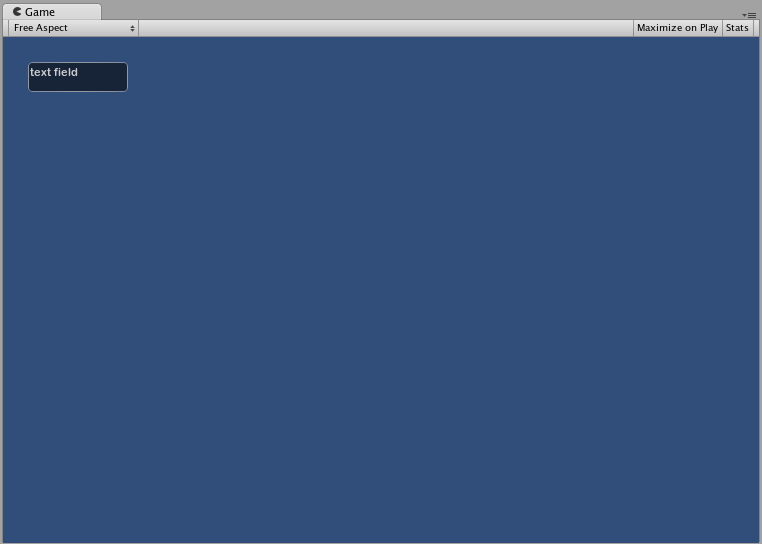
TextArea
TextArea コントロールは、テキスト文字列を含む、インタラクティブで、編集可能な複数行の領域です。
基本的な使用例
TextArea は、常に文字列を表示します。TextArea に表示する文字列を用意する必要があります。文字列に編集を行うと、TextArea 関数は編集した文字列を返します。
/* GUI.TextArea の例 */
using UnityEngine;
using System.Collections;
public class GUITest : MonoBehaviour
{
private string textAreaString = "text area";
void OnGUI ()
{
textAreaString = GUI.TextArea (new Rect (25, 25, 100, 30), textAreaString);
}
}
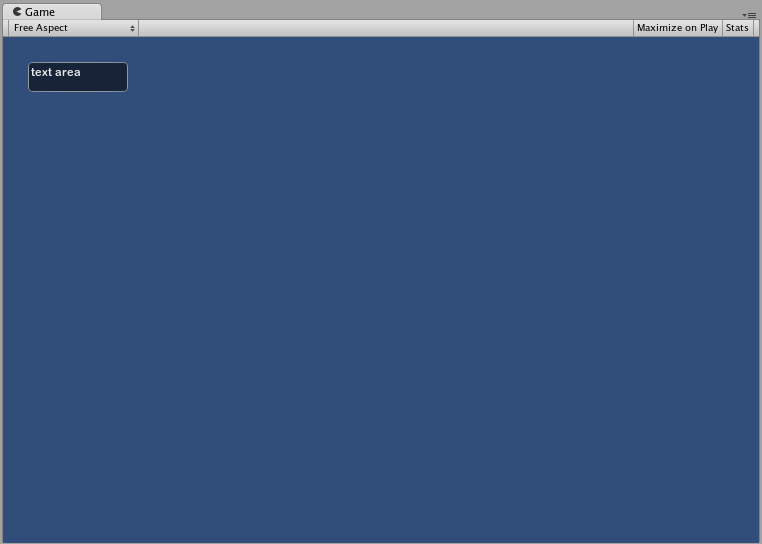
Toggle
Toggle コントロールは、持続するオン/オフ状態を持つチェックボックスを作成します。ユーザーは、チェックボックスをクリックすることで、状態を切り替えられます。
基本的な使用例
Toggle のオン/オフ状態は、true/false のブール値で示されます。Toggle に実際の状態を表示させるために、パラメーターとして、ブール値を設定する必要があります。クリックすると、Toggle 関数は新しいブール値を返します。この相互作用を取得するには、ブール値を割り当て、Toggle 関数の戻り値を受け取る必要があります。
/*GUI.Toggle の例 */
using UnityEngine;
using System.Collections;
public class GUITest : MonoBehaviour
{
private bool toggleBool = true;
void OnGUI ()
{
toggleBool = GUI.Toggle (new Rect (25, 25, 100, 30), toggleBool, "Toggle");
}
}
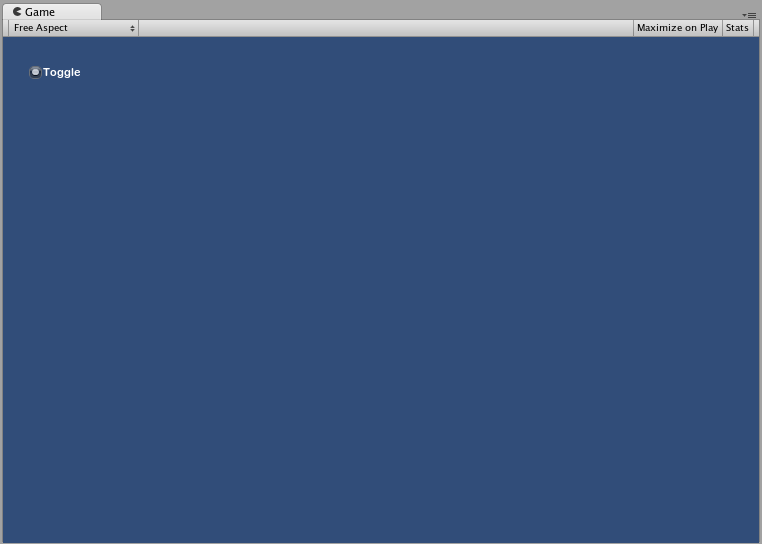
Toolbar
Toolbar コントロールは基本的に Button でできた行です。一度に有効にできるのはツールバー上の Button 1 つだけで、別の Button がクリックされるまで有効になります。この動作は、通常のツールバーの動作と同じです。ツールバーでは任意の数の Button を定義できます。
基本的な使用例
ツールバーのアクティブな状態の Button は、整数で追跡できます。関数の引数として整数を設定します。ツールバーをインタラクティブにするには、関数の戻り値に整数を割り当てる必要があります。作成する配列の要素数によって、ツールバー内に表示できる Button の数が決まります。
/*GUI.Toolbar の例*/
using UnityEngine;
using System.Collections;
public class GUITest : MonoBehaviour
{
private int toolbarInt = 0;
private string[] toolbarStrings = {"Toolbar1", "Toolbar2", "Toolbar3"};
void OnGUI ()
{
toolbarInt = GUI.Toolbar (new Rect (25, 25, 250, 30), toolbarInt, toolbarStrings);
}
}
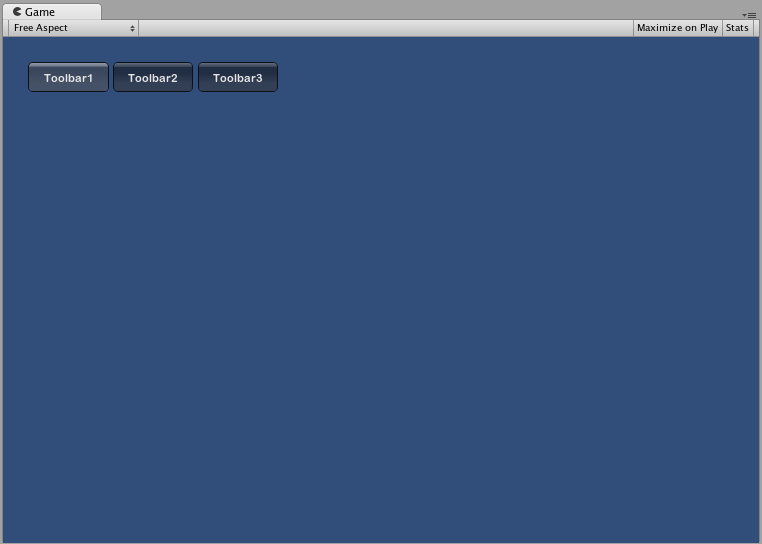
SelectionGrid
SelectionGrid コントロールは複数行の ツールバー です。グリッドの行と列の数を決定できます。一度にアクティブにできる Button の数は 1 つだけです。
基本的な使用例
SelectionGrid でアクティブな Button は、整数で追跡できます。関数の引数として整数を設定します。SelectionGrid をインタラクティブにするには、関数の戻り値に整数を割り当てる必要があります。作成する配列の要素数によって、SelectionGrid 内に表示される Button の数が決まります。関数の引数を通じて、コラムの数も制御できます。
/*GUI.SelectionGrid の例 */
using UnityEngine;
using System.Collections;
public class GUITest : MonoBehaviour
{
private int selectionGridInt = 0;
private string[] selectionStrings = {"Grid 1", "Grid 2", "Grid 3", "Grid 4"};
void OnGUI ()
{
selectionGridInt = GUI.SelectionGrid (new Rect (25, 25, 300, 60), selectionGridInt, selectionStrings, 2);
}
}
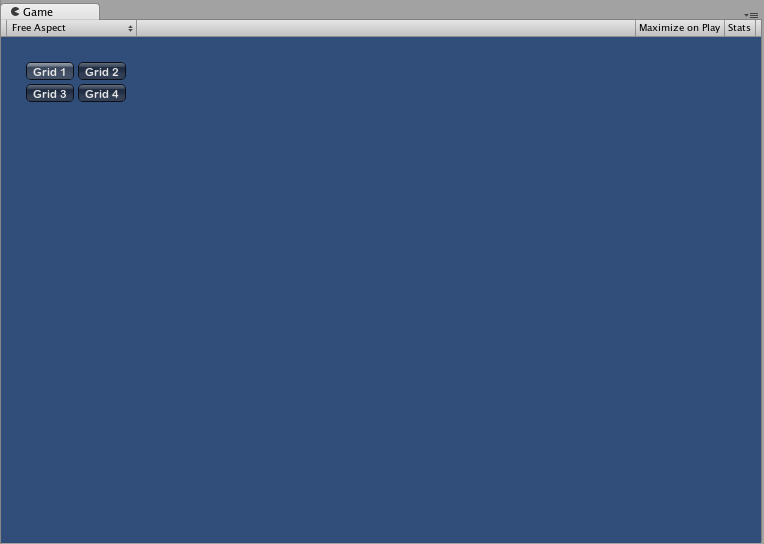
HorizontalSlider
HorizontalSlider コントロールは通常の水平スライダーで、ドラッグして事前に設定された最小と最大値間の値を変更します。
基本的な使用例
スライダーのつまみ位置は float で保存されます。ノブの位置を表示するには、関数内の引数の 1 つとして、その float 値を設定します。さらに、最小値と最大値を決定する 2 つの値を設定します。スライダーを調整可能にするため、スライダー値の float を Slider 関数の戻り値になるように割り当てます。
/*Horizontal Slider の例*/
using UnityEngine;
using System.Collections;
public class GUITest : MonoBehaviour
{
private float hSliderValue = 0.0f;
void OnGUI ()
{
hSliderValue = GUI.HorizontalSlider (new Rect (25, 25, 100, 30), hSliderValue, 0.0f, 10.0f);
}
}
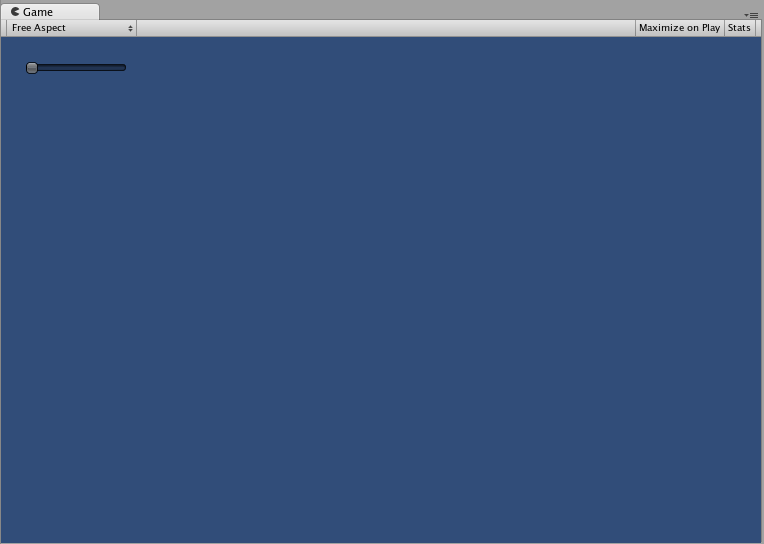
VerticalSlider
VerticalSlider コントロールは通常の垂直スライダーで、ドラッグして事前に設定された最小と最大値間の値を変更します。
基本的な使用例
スライダーのつまみ位置は float で保存されます。ノブの位置を表示するには、関数内の引数の 1 つとして、その float 値を設定します。さらに、最小値と最大値を決定する 2 つの値を設定します。スライダーを調整可能にするため、スライダー値の float を Slider 関数の戻り値になるように割り当てます。
/*Vertical Slider の例 */
using UnityEngine;
using System.Collections;
public class GUITest : MonoBehaviour
{
private float vSliderValue = 0.0f;
void OnGUI ()
{
vSliderValue = GUI.VerticalSlider (new Rect (25, 25, 100, 30), vSliderValue, 10.0f, 0.0f);
}
}
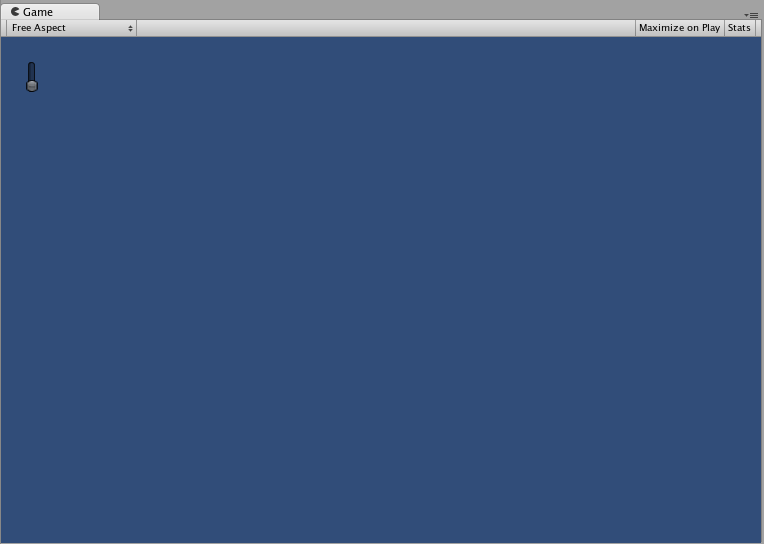
HorizontalScrollbar
HorizontalScrollbar コントロールは Slider コントロールと同じですが、Web ブラウザーやワードプロセッサーに対するスクロールの要素に見た目が似ています。このコントロールは、ScrollView コントロールを操作するのに使用されます。
基本的な使用例
Horizontal Scrollbar は、1 つの例外を除いて Horizontal Slider と全く同じに実装されます。その例外は、Scrollbar のノブの幅を制御する引数が 1 つ余分にあることです。
/*Horizontal Scrollbar の例*/
using UnityEngine;
using System.Collections;
public class GUITest : MonoBehaviour
{
private float hScrollbarValue;
void OnGUI ()
{
hScrollbarValue = GUI.HorizontalScrollbar (new Rect (25, 25, 100, 30), hScrollbarValue, 1.0f, 0.0f, 10.0f);
}
}
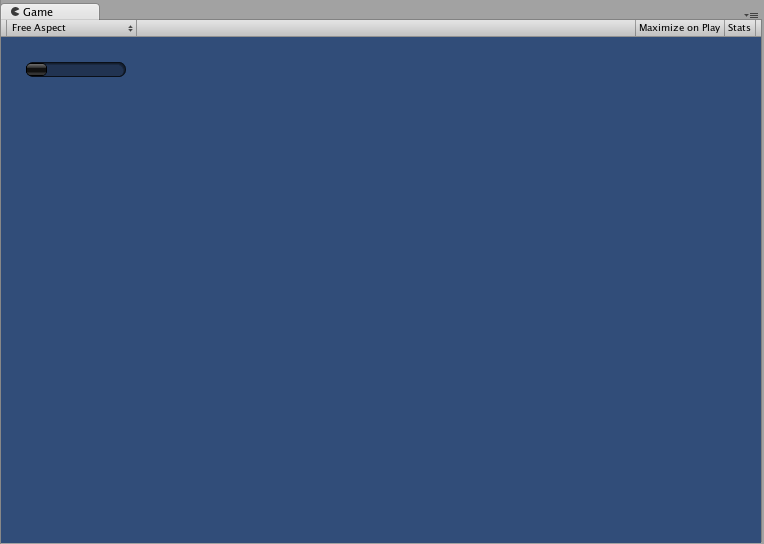
VerticalScrollbar
VerticalScrollbar コントロールは Slider コントロールと同じですが、Web ブラウザーやワードプロセッサーに対するスクロールの要素に見た目が似ています。このコントロールは、ScrollView コントロールを操作するのに使用されます。
基本的な使用例
Vertical Scrollbar は、1 つの例外を除いて Horizontal Slider と全く同じに実装されます。その例外は、Scrollbar のノブの高さを制御する引数が 1 つ余分にあることです。
/* Vertical Scrollbar の例 */
using UnityEngine;
using System.Collections;
public class GUITest : MonoBehaviour
{
private float vScrollbarValue;
void OnGUI ()
{
vScrollbarValue = GUI. VerticalScrollbar (new Rect (25, 25, 100, 30), vScrollbarValue, 1.0f, 10.0f, 0.0f);
}
}
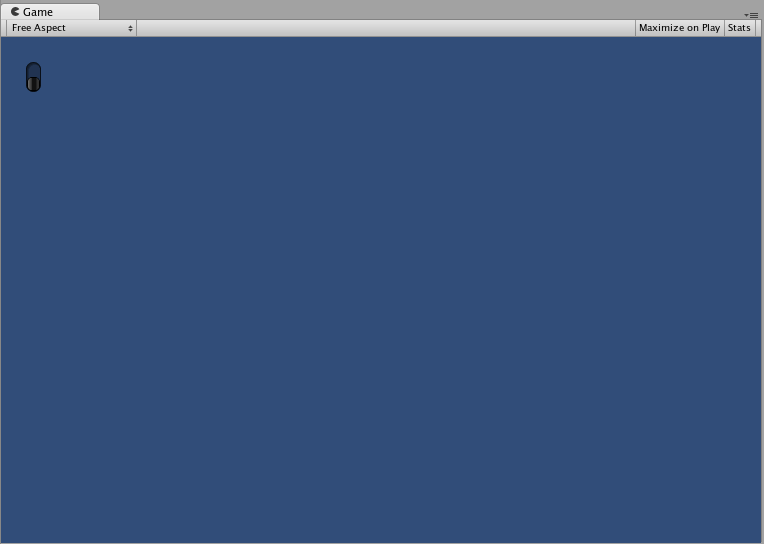
ScrollView
ScrollView は、はるかに大きいひとまとまりのコントロールから成る表示エリアを表示するコントロールです。
基本的な使用例
ScrollView は、引数として、2 つの Rect を必要とします。1 つ目の Rect は、画面上の表示できる ScrollView エリアの位置とサイズを定義します。2 つ目の Rect は、表示エリア内に含まれるスペースのサイズを定義します。エリア内の表示スペースが、エリアよりも大きい場合、スクロールバーは必要に応じて表示されます。表示される表示エリアの位置を格納する 2D Vector を割り当て設定する必要があります。
/*ScrollView の例*/
using UnityEngine;
using System.Collections;
public class GUITest : MonoBehaviour
{
private Vector2 scrollViewVector = Vector2.zero;
private string innerText = "I am inside the ScrollView";
void OnGUI ()
{
// ScrollView を開始
scrollViewVector = GUI.BeginScrollView (new Rect (25, 25, 100, 100), scrollViewVector, new Rect (0, 0, 400, 400));
// ScrollView の中に何かを表示
innerText = GUI.TextArea (new Rect (0, 0, 400, 400), innerText);
// ScrollView を終了
GUI.EndScrollView();
}
}
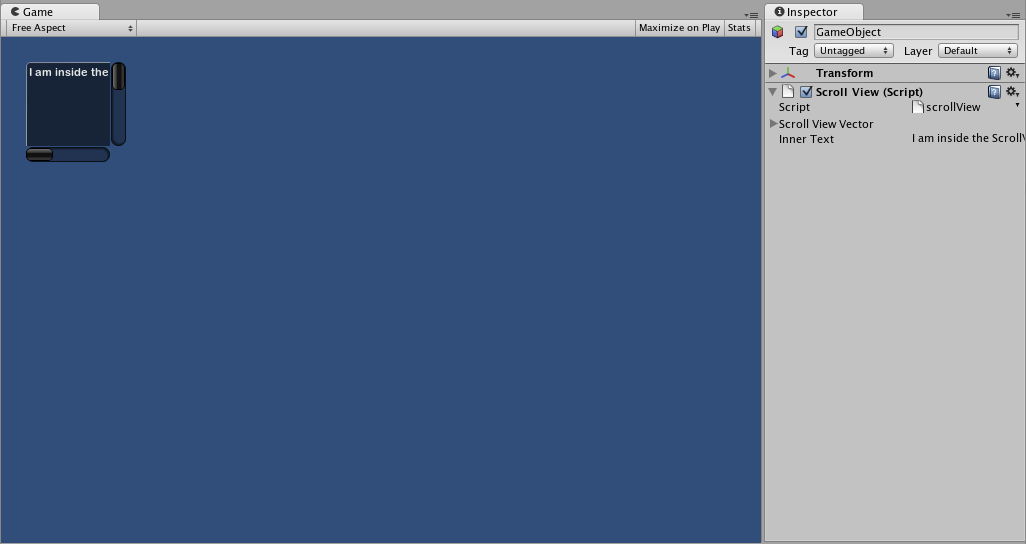
Window
Window は、ドラッグ可能なコンテナのコントロールです。Window はクリックすると、フォーカスを得たり、失ったりします。このため、他のコントロールとは若干異なる形で実装されます。各 Window には ID があり、そのコンテンツは、Window にフォーカスがあるときに呼び出される個々の関数内で宣言されます。
基本的な使用例
Window は、適切に機能するのに別の関数を必要とする唯一のコントロールです。ID 番号と Window で実行される関数名を渡す必要があります。Window 関数内で、実際の動作や含まれるコントロールを作成します。
/*Window の例*/
using UnityEngine;
using System.Collections;
public class GUITest : MonoBehaviour
{
private Rect windowRect = new Rect (20, 20, 120, 50);
void OnGUI ()
{
windowRect = GUI.Window (0, windowRect, WindowFunction, "My Window");
}
void WindowFunction (int windowID)
{
// ウィンドウ内のすべてのコントロールをここに記述します
}
}
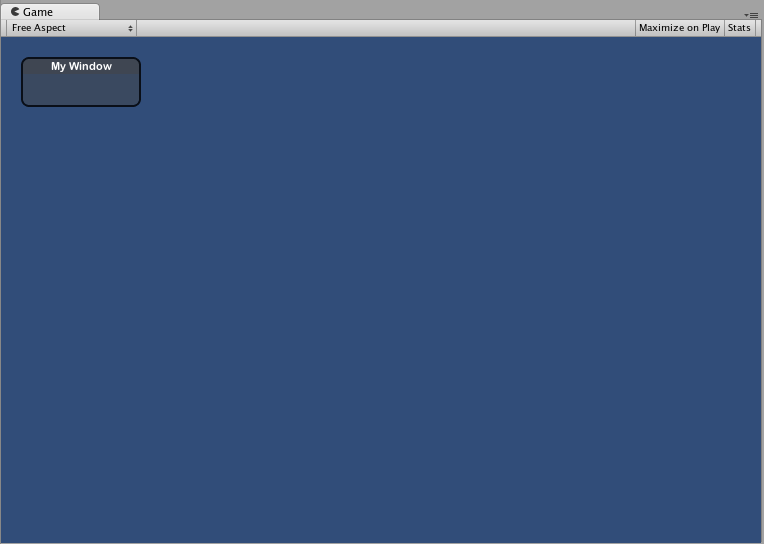
GUI.changed
ユーザーが GUI でなんらかのアクション (ボタンのクリック、スライダーのドラッグなど) を行ったかを検出するには、スクリプトから GUI.changed 値を読みます。ユーザーが何かを行なっている場合は true を取得し、ユーザー入力を簡単に検証できます。
よくあるシナリオはツールバーで、ツールバーでクリックされたボタンに基づき、特定の値を変更する場合です。ボタンの 1 つがクリックされている場合にのみ、OnGUI() を呼び出すたびに値を割り当てるのではなく、ボタンの 1 つがクリックされたときにのみ割り当てます。
/*GUI.changed の例*/
using UnityEngine;
using System.Collections;
public class GUITest : MonoBehaviour
{
private int selectedToolbar = 0;
private string[] toolbarStrings = {"One", "Two"};
void OnGUI ()
{
// Determine which button is active, whether it was clicked this frame or not
selectedToolbar = GUI.Toolbar (new Rect (50, 10, Screen.width - 100, 30), selectedToolbar, toolbarStrings);
// If the user clicked a new Toolbar button this frame, we'll process their input
if (GUI.changed)
{
Debug.Log("The toolbar was clicked");
if (0 == selectedToolbar)
{
Debug.Log("First button was clicked");
}
else
{
Debug.Log("Second button was clicked");
}
}
}
}
GUI.changed は、ユーザーが操作する前に GUI コントロールを設定した場合に true を返します。
Did you find this page useful? Please give it a rating:
Thanks for rating this page!
What kind of problem would you like to report?
Thanks for letting us know! This page has been marked for review based on your feedback.
If you have time, you can provide more information to help us fix the problem faster.
Provide more information
You've told us this page needs code samples. If you'd like to help us further, you could provide a code sample, or tell us about what kind of code sample you'd like to see:
You've told us there are code samples on this page which don't work. If you know how to fix it, or have something better we could use instead, please let us know:
You've told us there is information missing from this page. Please tell us more about what's missing:
You've told us there is incorrect information on this page. If you know what we should change to make it correct, please tell us:
You've told us this page has unclear or confusing information. Please tell us more about what you found unclear or confusing, or let us know how we could make it clearer:
You've told us there is a spelling or grammar error on this page. Please tell us what's wrong:
You've told us this page has a problem. Please tell us more about what's wrong:
Thank you for helping to make the Unity documentation better!
Your feedback has been submitted as a ticket for our documentation team to review.
We are not able to reply to every ticket submitted.